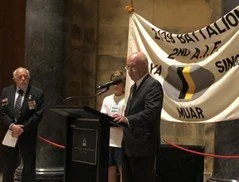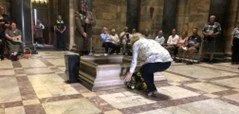Battle of Muar Commemoration
It was great to see so many attend the 2/29th Battalion AIF Association Battle of Muar Commemoration Service held at the Shrine on Sunday 19 January 2020.
Andrew Warland, Grandson of Lt. Col. John Robertson, spoke at the Shrine service.
2/29 Battalion memorial speech
As dawn broke on a warm and humid tropical morning just north of the Bakri crossroads, on 19 January 1942 (78 years ago) the confidence of the previous day - when Japanese assaults were successfully defeated and a company of tanks destroyed - was soon to be replaced with a new and grim reality.
During the night, the bulk of the Japanese forces had outflanked the battalion via the jungle to the west and was now moving against the newly arrived 2/19th and its B Echelon further back, as well as the 45th Brigade HQ.
The 600 or so men of the 2/29th- along with the anti-tank and other supporting units - were well-trained, disciplined, determined, confident and prepared to maintain their position, for as long as the road to the rear support and supply lines remained open.
But the road was now vulnerable.
The 2/29th, deployed across the Muar road at the 101-mile post, among rubber trees and surrounded by jungle and swamp, now found themselves in danger of being cut off.
For most of the men, the 19th of January - and the next days, weeks and months - would become an unimaginable test of personal survival that some would not survive.
We can only imagine what was going on in their minds. To quote Bob Christie ‘everybody was frightened’.
Japanese forces attacked the rear 2/19th Battalion from around 7.30 AM, cutting the road and communication between the two battalions.
Further to the rear, Brigade HQ was bombed during the morning. The 2/19th’s B Echelon, further back, also came under attack.
Left to wait the missing Jats, the men of the 2/29th were subject to constant assaults, artillery shelling, aerial bombardment, and mortar fire. There was no cover apart from slit trenches and the branches and foliage of the rubber trees.
The men could hear the familiar ‘plop’ sound of artillery shells being fired in the distance and waited for the shrill whine just before they hit. Metal shrapnel was a common injury and cause of death.
The Indian Jats that finally started to arrive from jungle tracks in the early afternoon would prove to be more of a nuisance than any strategic value.
As the day wore on and casualties increased, it was clear that the 2/29th could no longer maintain its position. According to the book ‘No Lost Battalion’, many fought with bayonet and grenade throughout the afternoon.
Major Olliff, the acting CO, told Lt Col Anderson that they could hold their position as long as the road was kept open.
But the road was not open. Japanese machine gun fire quickly stopped any attempt to use it.
The 2/29th was ordered to withdraw to the 2/19th position - after dark – via the jungle and swamp on the east side of the road. What started off as a strong defensive position became a trap.
A Company were to be followed by HQ Company, then C and B companies, followed by the wounded with Captain Brand and his medics, several drivers, anti-tank gunners and riflemen.
One truck, bravely driven by Jim Vague ‘with bullets going over the top and through the truck’, and a carrier managed to get through with some of the wounded but the rest of the trucks and carriers had to be abandoned.
Captain Brand’s group were left with no choice but to make for the jungle with the walking wounded. The more seriously wounded were left behind, their fate audible above the jungle noise.
Only around one third of the battalion managed to reach the 2/19th position that night. The Battalion roll states that a total of 38 or 39 men were killed on the 19th.
The fate of the remaining 350 or so men over the next few hours, days and weeks depended on many factors, including sheer luck – or bad luck.
Some, including Captain Brand’s small group, managed to re-join the combined force heading south before they reached Parit Sulong.
Others were handed in to or caught by Japanese patrols and imprisoned or executed, or just vanished.
Two groups managed to escape from Malaya. One, including Corporal McKay and Slim Nelson, commandeered a boat and ended up in Sumatra where they were captured and forced to work on the railway there. A second group of around 15 men led by Sgt Mick Gibbins, managed to make it all the way back to Australia.
Of the 600 or so men who fought at Bakri, only 130 men mustered at Yong Peng on 24 January (this number may not include the men from D Company or the members of B Echelon).
The 2/29th roll records that 163 men were killed in action from 17 to 24 January 1942. Given a similar or greater number that were still missing, 500 reinforcements were required when Col Pond took command.
The days from the evening of 17th January 1942 bore witness to stories of individual courage, bravery and heroism, self-sacrifice and support for mates, but also some poor judgement.
Above all, there was a determination to survive against the odds.
Those men who survived the battle for the Bakri crossroads, along with the reinforcements assigned to the battalion, would have to endure further struggles to survive as POWs, including on the Thai Burma Railway and other locations.
Today we honour - with pride - the memory of the brave men of the 2/29th - second to none. Lest we forget.
The wreath was laid by Diane Tuck.
Morning tea in the Western Gallery followed the service. Thank you to all who attended and made this service so memorable


